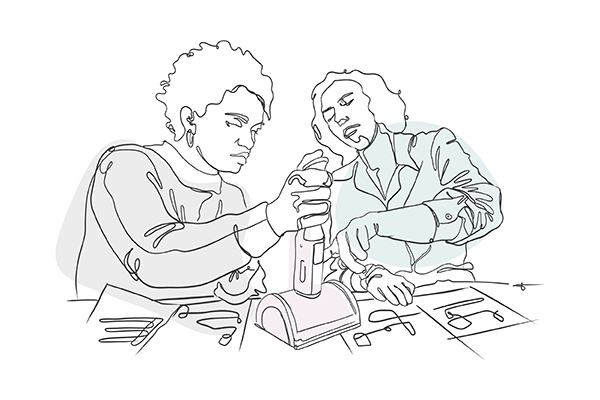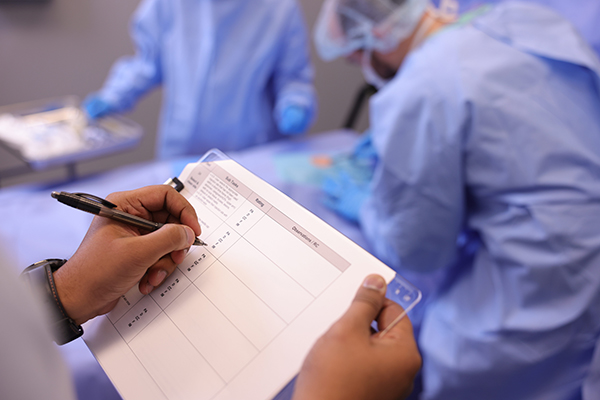Five Trends in Medical Device Regulations to Watch in 2024: A Human Factors Engineer’s Takeaways from the 10th Annual University of Georgia (UGA) x FDA Medical Device Regulations Conference
Author: Kellen Crosby
Happy New Year! Amidst all the holiday festivities, family, and gratitude, I could not think of a better way to kick the year off than with insights into the Food and Drug Administration (FDA) medical device regulations for new product development!
At the end of last year I had the opportunity to attend the 10th annual UGA-FDA 2023 Medical Device Regulations Conference. I participated in the conference to better understand what regulators need from designers and engineers. As a Human Factors Engineer, I think it is essential to step outside my own box to understand the medical device regulatory needs of the other teams I work with at THRIVE and our clients. The experience was incredibly valuable, and in the spirit of giving, I wanted to share some of my takeaways with you.
The goal of this article is to:
1. Discuss some of the medical device regulatory updates and trends I found interesting from the conference.
2. Share my key takeaways and possible resulting actions from these updates and trends.
3. Provide some resources that I have found helpful.
The UGA-FDA Medical Device Regulations Conference is an annual collaboration sponsored by the FDA and the University of Georgia’s Regulatory Sciences program that gathers industry, regulators, and academia in the same room to share ideas, gain insight, and stay abreast of the state of the medical device industry.
Updates and Trends:
1. The FDA is updating CFR 820 to emphasize risk.
The FDA is working on an update to CFR 820 aimed at codifying the definition and importance of risk as outlined by ISO 13485. There is also an increased expectation by the FDA for medical device manufacturers to have a Quality Management System (QMS) that emphasizes a risk-based approach to product development that integrates real-world data as it is collected to provide feedback for future development decisions.
Medical device manufacturers must stay current with these changes and update device documentation and their QMS to avoid getting flagged by the FDA.
This means manufacturers must build expertise in defining and mitigating risk and documenting the outcomes clearly for the FDA.
2. Software as a medical device (SaMD) and AI regulation is challenging.
The FDA is working to define validation more clearly for SaMD and understand how to regulate software, which comes with unique difficulties. The nature of software development is to “Move Fast and Break Things,” resulting in numerous updates, bug fixes, and releases. This is challenging for regulators who want a thorough analysis of the impact of changes to ensure user safety. Agile approaches may cause difficulties for manufacturers as the FDA increases their scrutiny, and worse yet, may cause harm to patients if changes are made too hastily.
The question that must be answered is, “How do we balance innovation with medical device regulations requirements and considerations?”
Speakers at the conference discussed different approaches to development and regulatory strategies, such as pre-determined change control plans and comparing Cross-Validation against External Validation. Conversations like this are becoming more and more commonplace between medical device manufacturers and the FDA as the need for more expertise in this area grows. Software development and regulatory approaches will be an important area to watch in the coming years.
3. Data security is a continuing concern.
In the same vein as the previous point, data security was an interesting topic discussed at the conference. Defending Protected Health Information (PHI) has always been important but is increasing as more healthcare data lives on connected devices. This trend has skyrocketed since the dawn of the internet, and data leaks are commonplace, resulting in sensitive patient data entering the public realm.
The internet was initially invented for sharing information, not securing it. That is why healthcare data security is, by its very nature, difficult to manage and secure. As the saying goes, “Someone can spend years building a 10-foot wall, and all you need to get over it is an 11-foot ladder.”
As a result, developers are becoming savvier by taking security into account from the start of new product development, as opposed to an afterthought. One conference presenter provided a helpful resource/organization called OWASP. Their website outlines their mission: “The Open Worldwide Application Security Project (OWASP) is a nonprofit foundation that works to improve the security of software.”
Their website [Resource 1] provides guidelines on best practices for companies to maintain software security.
4. Combination products are becoming increasingly commonplace.
The FDA conference presenters noted an increase in the number of combination products submitted to them in recent years. We expect this trend will continue to grow as wearable health monitors, aids, and drug-delivery types of devices are developed.
Combination products pose a challenge to device manufacturers and their regulatory teams because there are often contradictory points of view around determining the type of device classification as either primarily a drug or a medical device, which can be confusing.
The FDA has issued guidance on approaching these products [Resource 2]; even so, understanding the medical device regulations for these devices can be difficult.
Determining the correct classification for the type of device, setting regulatory strategy, and quality system regulation approaches early in the device development cycle can save manufacturers energy, time, and money.
One way to achieve this is by engaging the FDA early.
5. Early engagement with the FDA can save medical device manufacturers headaches.
Industry presenters at the conference outlined the value of planning early engagement with the FDA to solicit feedback on their development and testing strategies using Q-submissions. Hearing about the planning, requesting, and preparing a process for these engagements was incredibly valuable.
Q-submissions are a great way to get semi-formal, non-binding feedback from FDA reviewers. This is a great way to introduce your device to reviewers and gain valuable insights about requirements and considerations the FDA wants addressed in your Verification and Validation plans.
Learning when to get feedback and how to frame these meetings can eliminate surprises or delays in your submission process. With the speed of medical device development and updates from the FDA, manufacturers that master these tools will have a leg up on their competition.
Key Takeaways:
Human Factors Engineers Can Help Medical Device Manufacturers Navigate the Increased Focus on Risk Management
As outlined in the International Usability Standards as guided by the FDA, Human Factors Engineers continuously assess risk in the design process of a medical device. We use a systematic approach, combined with our expertise in usability principles, medical device design, and human behavior, to understand where use errors may arise through interaction with the device as it is being developed. Incorporating our expertise early and often throughout device design and development will ensure that risk identification and mitigation are prioritized and handled effectively as required by the FDA’s medical device regulations.
Cross-functional engagement is more critical than ever in medical device design.
There is an increased need for cross-functional collaboration between manufacturing teams and regulators to understand the best approach to designing and developing medical devices. Doing so will eliminate headaches and avoid costly delays, primarily if the FDA identifies significant risks and deficiencies in the device design or the design and development process. Sharing your approach sooner will allow the FDA to provide timely feedback that can be used to improve the development of your type of device without delaying timelines.
A thank you to the organizers.
Opportunities to attend conferences like this are incredibly valuable for regulatory teams and all functions involved in medical device development. This allows all the functions to understand each other’s goals, priorities, and ways of working so that we can be more effective medical device design and development teams. I want to thank the organizers of this event from UGA and the FDA for making themselves available to us. I am excited to see this conference continue to grow and impact great medical device design in the future.
________________________________________________________________
If you have any questions about the FDA or Human Factors in medical device development, contact us today to start the conversation.
________________________________________________________________
Resources
[1] OWASP Website: A vital resource for understanding best practices in software security, beneficial for SaMD developers: https://owasp.org
[2] FDA Guidance on Combination Products: Essential guidance for navigating the regulatory landscape of combination medical devices: https://www.fda.gov/combination-products/guidance-regulatory-information/combination-products-guidance-documents
________________________________________________________________
Human Factors Engineering At THRIVE
THRIVE’s Human Factors professionals have decades of experience applying Human Factors to products ranging from medical devices used by specialized healthcare professionals in clinical environments to combination products used by laypeople in the home.
If it’s your first time applying Human Factors and you need a comprehensive end-to-end Human Factors program, we’ll scope out the program and conduct the activities on your behalf, leaving you time and resources to focus elsewhere. If you’re a resource-constrained HFE professional, we’ll provide the teamwork, collaboration, and support to help you meet your goals. Or, if you want a final sanity check to ensure you’ve met the latest and greatest expectations, we’ll do that, too.
Contact us today to get the conversation started.
ATLANTA | CHICAGO











